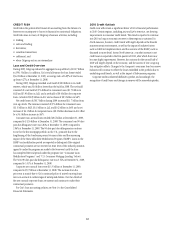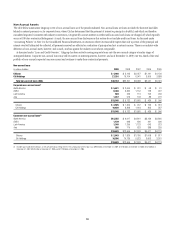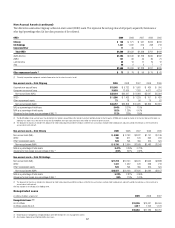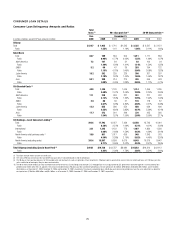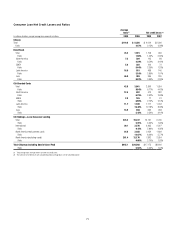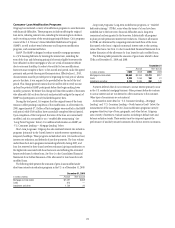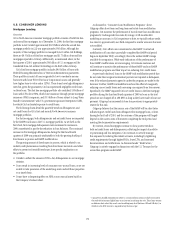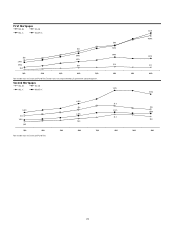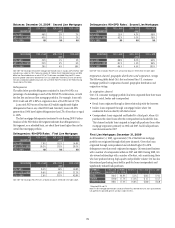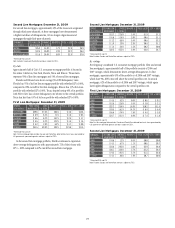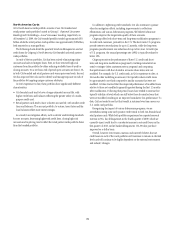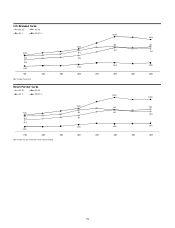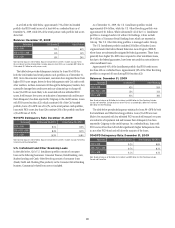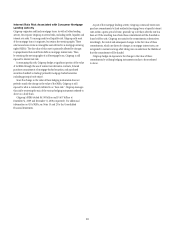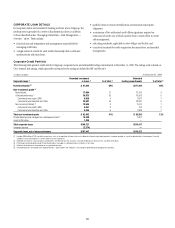Citibank 2009 Annual Report Download - page 82
Download and view the complete annual report
Please find page 82 of the 2009 Citibank annual report below. You can navigate through the pages in the report by either clicking on the pages listed below, or by using the keyword search tool below to find specific information within the annual report.
72
Consumer Loan Modification Programs
Citigroup has instituted a variety of modification programs to assist borrowers
with financial difficulties. These programs include modifying the original
loan terms, reducing interest rates, extending the remaining loan duration
and/or waiving a portion of the remaining principal balance. Citi’s programs
consist of the U.S. Treasury’s Home Affordable Modification Program
(HAMP), as well as short-term forbearance and long-term modification
programs, each summarized below.
HAMP. The HAMP is designed to reduce monthly mortgage payments
to a 31% housing debt ratio by lowering the interest rate, extending the
term of the loan and forbearing principal of certain eligible borrowers who
have defaulted on their mortgages or who are at risk of imminent default
due to economic hardship. In order to be entitled to loan modifications,
borrowers must complete a three- to five-month trial period, make the agreed
payments and provide the required documentation. Effective June 1, 2010,
documentation must be provided prior to beginning the trial period, whereas
prior to that date, it was required to be provided before the end of the trial
period. This change generally means that Citi will be able to verify income
up front for potential HAMP participants before they begin making lower
monthly payments. We believe this change will limit the number of borrowers
who ultimately fall out from the trials and potentially mitigate the impact of
HAMP trial participants on early bucket delinquency data.
During the trial period, Citi requires that the original terms of the loans
remain in effect pending completion of the modification. As of December 31,
2009, approximately $7.1 billion of first mortgages were enrolled in the HAMP
trial period, while $300 million have successfully completed the trial period.
Upon completion of the trial period, the terms of the loan are contractually
modified, and it is accounted for as a “troubled debt restructuring” (see
“Long-Term Programs” below). For additional information on HAMP, see
“U.S. Consumer Lending— Mortgage Lending” below.
Short-term programs. Citigroup has also instituted interest rate reduction
programs (primarily in the United States) to assist borrowers experiencing
temporary hardships. These programs include short-term (12 months or less)
interest rate reductions and deferrals of past due payments. The loan volume
under these short-term programs increased significantly during 2009, and
loan loss reserves for these loans have been enhanced, giving consideration to
the higher risk associated with those borrowers and reflecting the estimated
future credit losses for those loans. See Note 1 to the Consolidated Financial
Statements for a further discussion of the allowance for loan losses for such
modified loans.
The following table presents the amounts of gross loans modified under
short-term interest rate reduction programs in the U.S. as of December 31, 2009:
December 31, 2009
In millions of dollars Accrual Non-accrual
Mortgage and real estate $7,087 $398
Cards 813 —
Installment and other 1,734 29
Long-term programs. Long-term modification programs, or “troubled
debt restructurings” (TDRs), occur when the terms of a loan have been
modified due to the borrowers’ financial difficulties and a long-term
concession has been granted to the borrower. Substantially all programs
in place provide permanent interest rate reductions. Valuation allowances
for TDRs are determined by comparing estimated cash flows of the loans
discounted at the loans’ original contractual interest rates to the carrying
value of the loans. See Note 1 to the Consolidated Financial Statements for a
further discussion of the allowance for loan losses for such modified loans.
The following table presents the amounts of gross loans related to these
TDRs as of December 31, 2009 and 2008:
December 31
Accrual Non-accrual
In millions of dollars 2009 2008 2009 2008
Mortgage and real estate $8,654 $4,364 $1,413 $207
Cards 2,303 1,054 150 41
Installment and other 3,128 2,345 250 141
Payment deferrals that do not continue to accrue interest primarily occur
in the U.S. residential mortgage business. Other payment deferrals continue
to accrue interest and are not deemed to offer concessions to the customer.
Other types of concessions are not material.
As discussed in more detail in “U.S. Consumer Lending—Mortgage
Lending” and “U.S. Consumer Lending—North America Cards” below, the
measurement of the success of Citi’s loan modification programs varies by
program objectives, type of loan, geography, and other factors. Citigroup
uses a variety of metrics to evaluate success, including re-default rates and
balance reduction trends. These metrics may be compared against the
performance of similarly situated customers who did not receive concessions.



